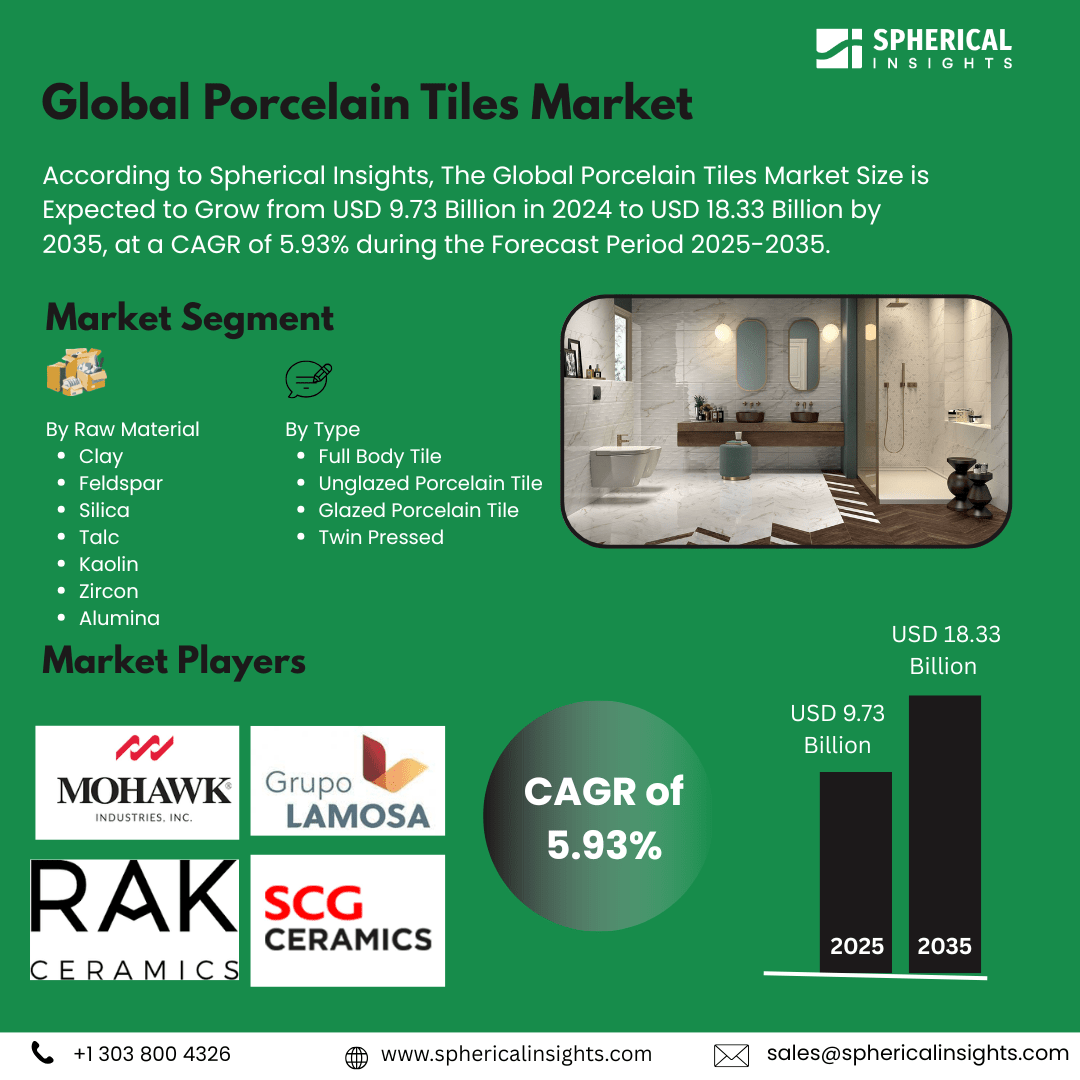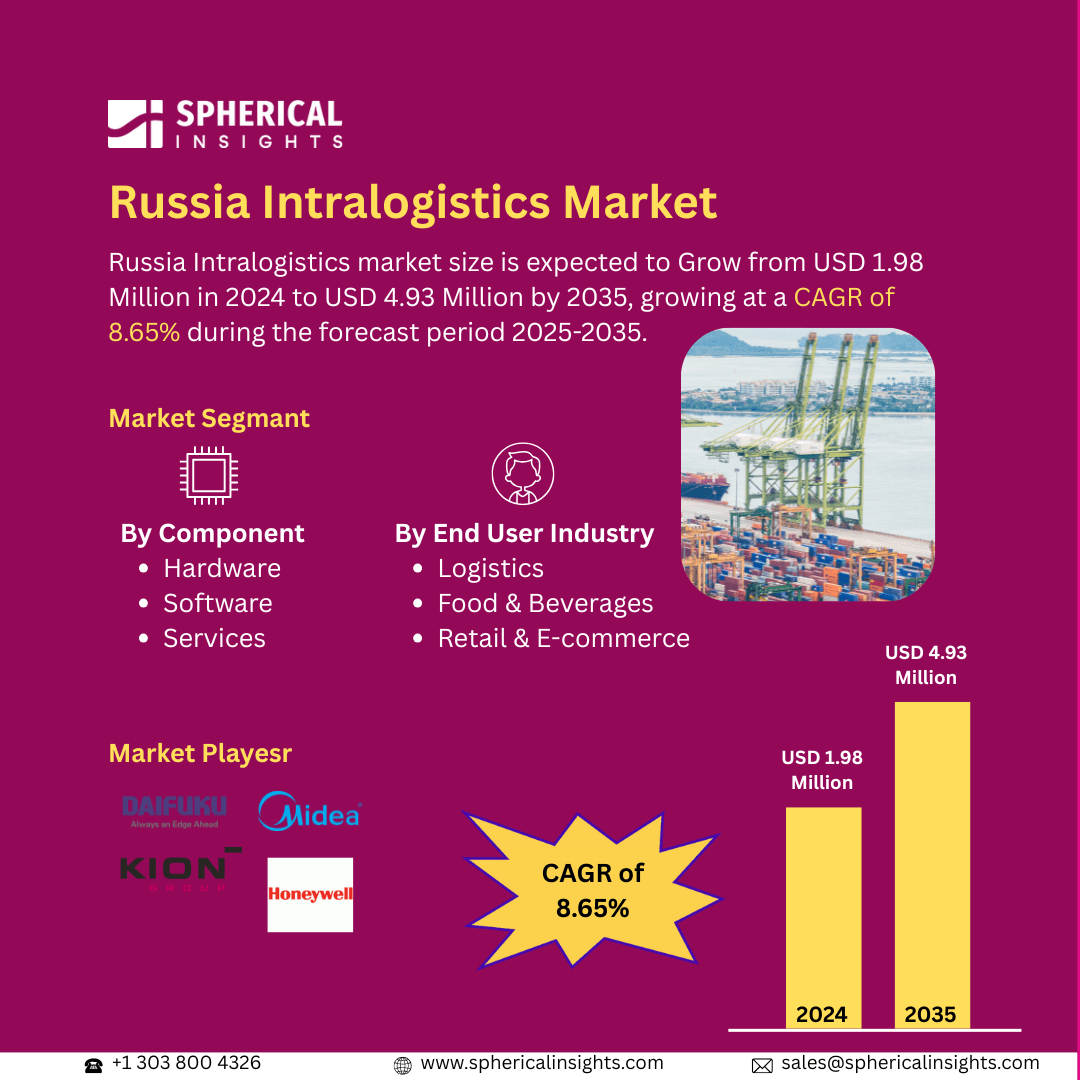Porcelain Tiles Market Summary, Size & Emerging Trends
According to Spherical Insights, The Global Porcelain Tiles Market Size is Expected to Grow from USD 9.73 Billion in 2024 to USD 18.33 Billion by 2035, at a CAGR of 5.93% during the Forecast Period 2025-2035. Rising urbanization and modernization are driving increased demand for durable and stylish porcelain tiles in construction.
Key Market Insights
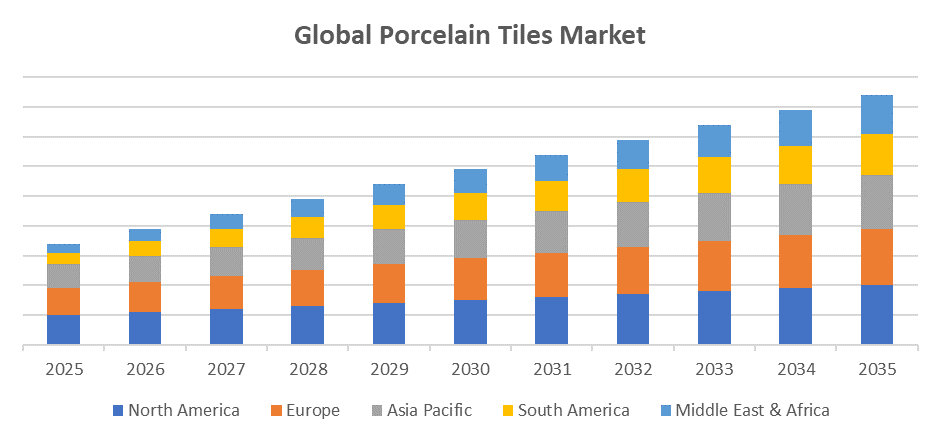
- Asia Pacific is expected to account for the largest share in the porcelain tiles market during the forecast period.
- In terms of raw material, the kaolin segment is projected to lead the porcelain tiles market throughout the forecast period
- In terms of type, the glazed porcelain tile segment captured the largest portion of the porcelain tiles market
Global Market Forecast and Revenue Outlook
- 2024 Market Size: USD 9.73 Billion
- 2035 Projected Market Size: USD 18.33 Billion
- CAGR (2025-2035): 5.93%
- Asia Pacific: Largest market in 2024
- North America: Fastest growing market
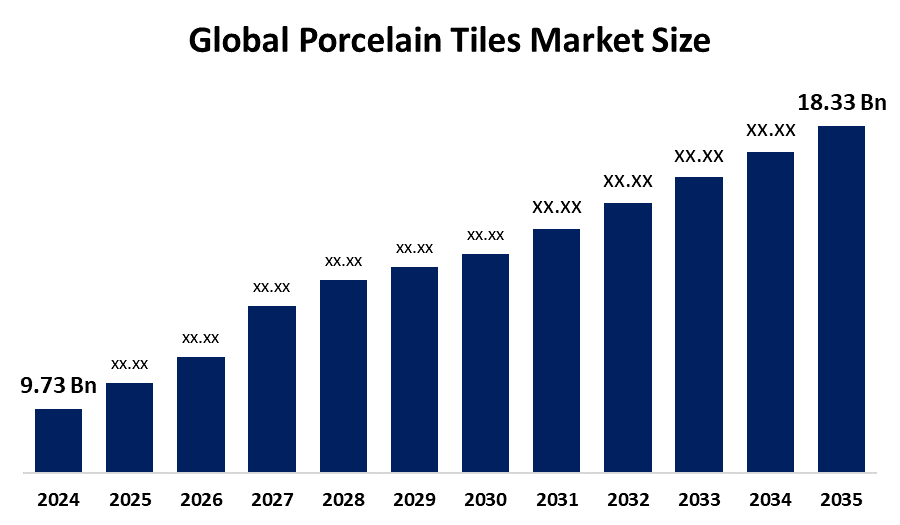
Porcelain Tiles Market
The Global Porcelain Tiles Market Size involves the production and supply of highly durable, low-porosity tiles made from refined clay, widely used for flooring and wall applications. Porcelain tiles are favored for their strength, water resistance, and aesthetic versatility, making them popular in residential, commercial, and industrial construction. Governments globally support the market through initiatives promoting sustainable building materials, encouraging the adoption of eco-friendly and long-lasting products like porcelain tiles. These initiatives align with broader goals of energy efficiency and environmental conservation. Technological advancements in manufacturing have enhanced tile designs, quality, and cost-efficiency, boosting market growth. Additionally, increasing urbanization and infrastructure development fuel demand for high-performance building materials. The market also benefits from growing consumer interest in modern interior design and renovation projects. Overall, the global porcelain tiles market is set to grow steadily, driven by government support, innovation, and rising demand in construction and home improvement sectors.
Porcelain Tiles Market Trends
- Increasing demand for environmentally friendly and energy-efficient building materials is driving the adoption of porcelain tiles made with sustainable manufacturing processes.
- The market is seeing a rise in large-format and ultra-thin porcelain tiles, offering sleek aesthetics and easier installation, popular in modern architectural designs.
- Advanced digital printing allows for more intricate, realistic designs and textures on porcelain tiles, expanding style options for consumers.
- Integration of functional features like anti-bacterial coatings, slip resistance, and enhanced durability is becoming a growing trend to meet safety and hygiene standards.
Porcelain Tiles Market Dynamics
Driving Factors: Growing demand for stylish, low-maintenance porcelain tiles is boosting the porcelain tiles market
Key growth factors driving the global porcelain tiles market include increasing urbanization and rapid infrastructure development, which boost demand for durable and high-quality flooring solutions. Growing consumer preference for aesthetically appealing and low-maintenance tiles in residential and commercial spaces also fuels market expansion. Technological advancements in manufacturing processes enhance tile designs, durability, and cost-effectiveness, attracting more buyers. Additionally, government initiatives promoting sustainable and eco-friendly building materials support market growth. Rising renovation activities and the trend toward modern interior design further contribute to the increasing adoption of porcelain tiles worldwide, making the market poised for steady growth.
Restrain Factors: High cost of premium porcelain tiles in the porcelain tiles market limits adoption in some regions.
Restraining factors for the porcelain tiles market include the high cost of premium porcelain tiles compared to alternative flooring materials, which can limit adoption in price-sensitive markets. The heavyweight of porcelain tiles increases transportation and installation challenges, adding to overall project costs. Additionally, the need for skilled labor during installation can slow down project timelines and raise expenses. Limited awareness about the benefits of porcelain tiles in some regions also restricts market growth. Lastly, fluctuations in raw material prices and supply chain disruptions may impact production costs and availability, posing challenges to consistent market expansion.
Opportunity: Expanding renovation and remodeling activities in the porcelain tiles market offer significant growth potential
Rising consumer preference for modern and durable flooring solutions opens avenues for market expansion. Innovations in tile design, such as digital printing and large-format tiles, provide opportunities to attract style-conscious customers. Additionally, the growing focus on sustainable and eco-friendly building materials encourages the development and adoption of green porcelain tiles. Expanding renovation and remodeling activities in residential and commercial sectors also offer potential for market growth. Furthermore, emerging economies with rising disposable incomes and infrastructure development present untapped markets. Collaborations between manufacturers and construction companies to promote advanced porcelain tiles can further accelerate market penetration and revenue generation.
Challenges: Fluctuations in raw material prices impact the porcelain tiles market’s production costs and profitability.
Challenges in the porcelain tiles market include high production and installation costs, which can deter budget-conscious buyers. The heavy weight of porcelain tiles increases transportation and handling difficulties, impacting overall project expenses. Limited skilled labor for proper installation can lead to delays and quality issues. Additionally, competition from alternative flooring materials like vinyl and laminate poses a threat. Fluctuations in raw material prices and supply chain disruptions also create uncertainty, affecting consistent production and market stability.
Global Porcelain Tiles Market Ecosystem Analysis
The global porcelain tiles market ecosystem includes raw material suppliers, manufacturers, distributors, and end-users across residential, commercial, and industrial sectors. Manufacturers use advanced technologies like digital printing and sustainable production methods. Distribution channels span offline retail and growing e-commerce platforms. Key players focus on innovation and eco-friendly products. The market is driven by urbanization, infrastructure growth, and rising demand for durable, low-maintenance tiles. Asia-Pacific leads production and consumption, while Europe and North America focus on design and renovation activities, respectively.
Global Porcelain Tiles Market, By Raw Material
The kaolin segment, accounting for 39.91%, is projected to lead the porcelain tiles market throughout the forecast period. Kaolin is a vital raw material in porcelain tile manufacturing due to its unique physical and chemical properties. It provides excellent whiteness, plasticity, and strength to the tiles, enhancing their durability and aesthetic appeal. Its high alumina content improves the tile’s resistance to heat and wear, making it ideal for both residential and commercial applications. Because of these qualities, kaolin dominates the raw material composition, supporting the production of high-quality porcelain tiles that meet market demands for durability and design.
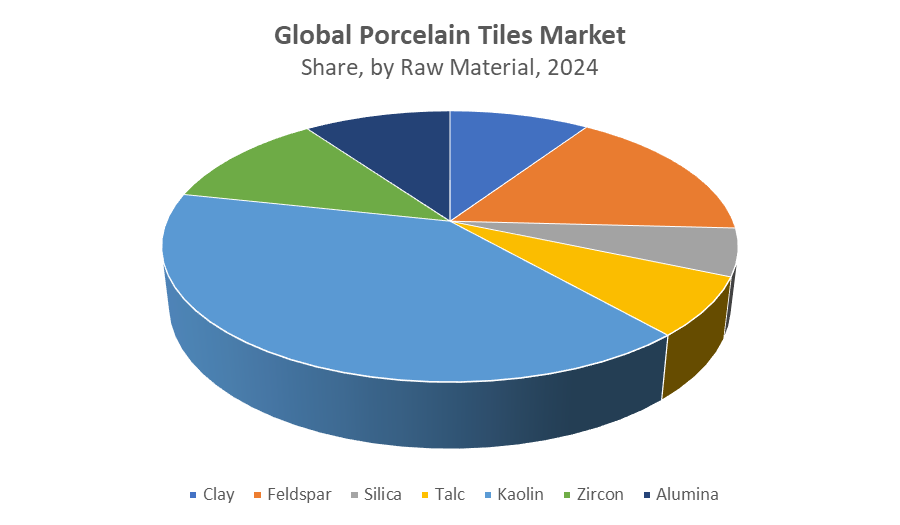
The feldspar segment, accounting for approximately 16.43%, accounted for the major revenue share over the forecast period. Feldspar is a key raw material in porcelain tile production due to its fluxing properties, which help lower the melting temperature of the mixture during firing. This improves manufacturing efficiency and results in tiles with enhanced strength and durability. Additionally, feldspar contributes to the tile’s resistance to chemical corrosion and weathering, making it highly suitable for both indoor and outdoor applications. Its significant role in optimizing production processes and improving product quality supports feldspar’s position as a major revenue-generating segment in the porcelain tiles market.
Global Porcelain Tiles Market, By Type
The glazed porcelain tile segment captured the largest portion of the porcelain tiles market. Glazed porcelain tiles are highly popular due to their enhanced aesthetic appeal, wide variety of colors and patterns, and improved surface protection. The glazing process creates a smooth, non-porous layer that increases stain resistance, durability, and ease of maintenance. These qualities make glazed porcelain tiles ideal for both residential and commercial applications, driving their dominant market share and strong consumer preference.
The full body tile segment accounted for a significant revenue share of the global porcelain tiles market during the forecast period. Full body porcelain tiles are made from the same material throughout their entire thickness, which gives them superior strength and durability. This makes them highly resistant to wear, chipping, and impact, ideal for high-traffic areas like commercial buildings, airports, and public spaces. Unlike glazed tiles, any surface damage is less noticeable because the color and texture run consistently through the tile.
Asia Pacific is expected to account for the largest share, approximately 48%, of the porcelain tiles market during the forecast period, driven by rapid urbanization, growing infrastructure projects, and rising demand for high-quality construction materials. As urban populations in countries like China and India expand, there’s a surge in residential, commercial, and industrial construction, increasing the demand for durable and aesthetically appealing flooring materials like porcelain tiles. These tiles are highly favored due to their strength, water resistance, and versatility in design, especially as consumers seek modern and stylish interiors. The region’s economic growth, rising disposable incomes, and a shift toward premium building materials further fuel the demand.
India is experiencing steady and significant growth in the porcelain tiles market, with an expected market share of approximately 12% during the forecast period. The country's rapid urbanization, with millions of people moving to cities, is driving demand for residential and commercial buildings. As the real estate sector expands, there’s a growing preference for high-quality and durable flooring materials, with porcelain tiles being a top choice due to their aesthetic appeal and long-lasting nature. Additionally, rising disposable incomes and changing consumer preferences are encouraging middle-class families to invest in modern and stylish interiors.
North America is expected to grow at the fastest CAGR, approximately 18%, in the porcelain tiles market during the forecast period, driven by robust construction and renovation activities across residential and commercial sectors, as well as increasing consumer preference for durable, low-maintenance, and aesthetically versatile flooring options. The rising trend of home improvement projects, coupled with technological advancements and innovative tile designs, is further fueling demand.
Canada’s porcelain tiles market is experiencing steady growth, with an estimated market share of approximately 5% during the forecast period. This growth is supported by ongoing residential and commercial construction projects, along with increasing consumer preference for durable and stylish flooring solutions. The country’s focus on sustainable building practices and home renovation trends also contribute to the consistent demand for porcelain tiles in the Canadian market.
WORLDWIDE TOP KEY PLAYERS IN THE PORCELAIN TILES MARKET INCLUDE
- Mohawk Industries
- RAK Ceramics
- Grupo Lamosa
- SCG Ceramics
- Pamesa Cerámica
- Kajaria Ceramics
- Ceramiche Atlas Concorde
- Crossville Inc.
- Panariagroup Industrie Ceramiche
- Villeroy & Boch
Product Launches in Porcelain Tiles
- In September 2023, Porcelanosa Grupo launched antibacterial glazed ceramic floor tiles embedded with silver ions. This innovation enhances both hygiene and durability, with the company producing approximately 150 million square meters annually.
Market Segment
This study forecasts revenue at global, regional, and country levels from 2020 to 2035. Spherical Insights has segmented the porcelain tiles market based on the below-mentioned segments:
Global Porcelain Tiles Market, By Raw Material
- Clay
- Feldspar
- Silica
- Talc
- Kaolin
- Zircon
- Alumina
Global Porcelain Tiles Market, By Type
- Full Body Tile
- Unglazed Porcelain Tile
- Glazed Porcelain Tile
- Twin Pressed
Global Porcelain Tiles Market, By Regional Analysis
- North America
- Europe
- Germany
- UK
- France
- Italy
- Spain
- Russia
- Rest of Europe
- Asia Pacific
- China
- Japan
- India
- South Korea
- Australia
- Rest of Asia Pacific
- South America
- Brazil
- Argentina
- Rest of South America
- Middle East & Africa
- UAE
- Saudi Arabia
- Qatar
- South Africa
- Rest of the Middle East & Africa
FAQs
Q1: What is the projected market size of the global porcelain tiles industry by 2035?
A: The global porcelain tiles market is expected to reach USD 18.33 billion by 2035, growing from USD 9.73 billion in 2024, with a CAGR of 5.93% over the forecast period 2025–2035.
Q2: Which region is leading the global porcelain tiles market, and which is growing the fastest?
A: Asia Pacific holds the largest market share, driven by rapid urbanization and construction in countries like China and India. Meanwhile, North America is expected to experience the fastest growth, with a projected CAGR of approximately 18% due to rising home renovation trends.
Q3: What factors are driving the growth of the porcelain tiles market?
A: Key growth drivers include urbanization, infrastructure development, technological advancements in tile manufacturing, and increased consumer preference for durable, low-maintenance, and visually appealing flooring solutions.
Q4: Which raw material dominates the porcelain tiles production, and why?
A: Kaolin leads the raw materials segment, accounting for nearly 40% of the market due to its whiteness, plasticity, and high alumina content, which enhance tile durability and resistance to heat and wear.
Q5: What are the major challenges impacting the porcelain tiles market?
A: Major challenges include high installation costs, weight-related transportation issues, fluctuations in raw material prices, and limited awareness in emerging markets.
Q6: What are the latest trends influencing porcelain tile design and functionality?
A: Key trends include the adoption of large-format and ultra-thin tiles, advanced digital printing for realistic textures, and the integration of functional features like antibacterial coatings and slip resistance.
Q7: Which type of porcelain tile holds the largest market share, and what makes it popular?
A: Glazed porcelain tiles dominate the market due to their aesthetic variety, stain resistance, and low maintenance, making them suitable for both residential and commercial applications.
Q8: Who are the key players operating in the global porcelain tiles market?
A: Leading companies include Mohawk Industries, RAK Ceramics, Grupo Lamosa, SCG Ceramics, Kajaria Ceramics, Pamesa Cerámica, Panariagroup, Atlas Concorde, Crossville Inc., and Villeroy & Boch.
